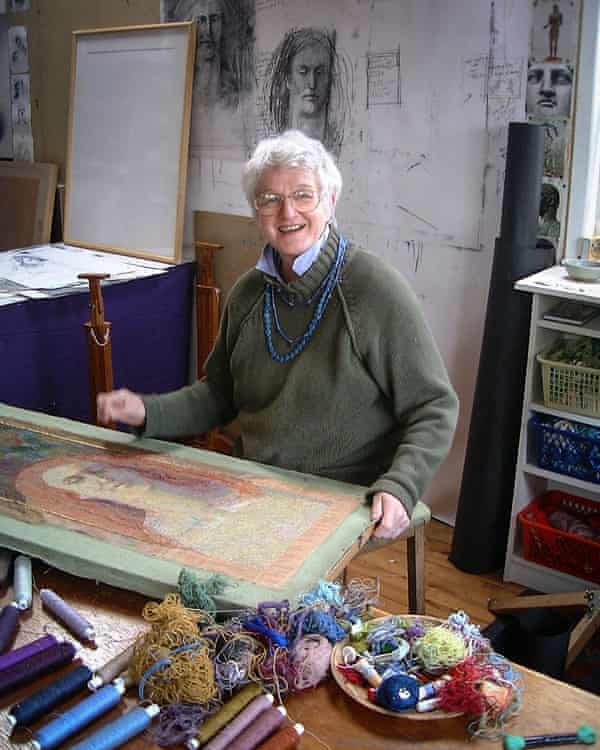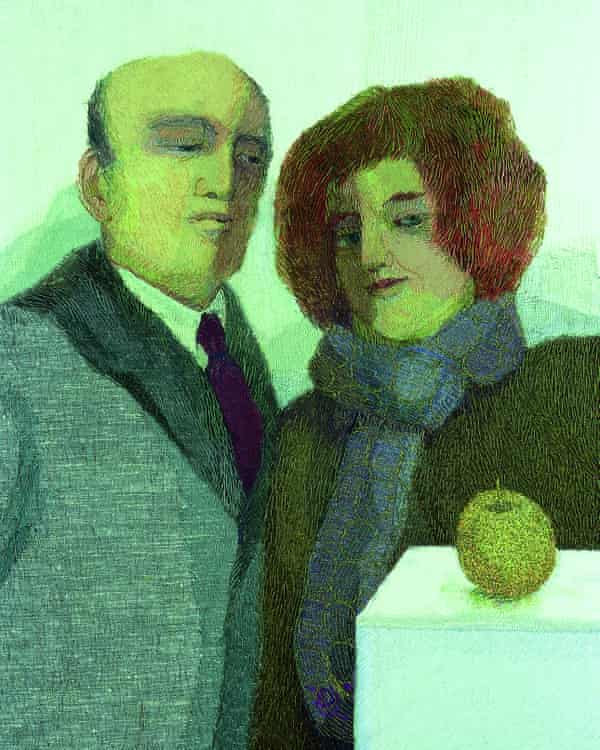Audrey Walker obituary
The textile artist Audrey Walker, who has died aged 92, was famend for embroideries constructed up from pointillist layers of thread – machine and hand-stitched. Her most interesting works, seen at a retrospective exhibition in 2000 at Ruthin Craft Centre in north Wales, had been created after her retirement from educating within the late Nineteen Eighties.
Psychologically unsettling figurative wall items, monumental in temper, they had been impressed by historic textiles, by archaic Greek sculpture, and by the artwork of the early Renaissance. Capturing refined gazes and glances, Walker’s haunting embroideries led Philip Hughes, the centre’s director, to watch: “If Virginia Woolf had stitched, this is what it would be like.”
Walker additionally had a distinguished profession in educating, culminating in her management of the textile and embroidery division at Goldsmiths College, London (now Goldsmiths, University of London) from 1975 to 1988, the place she constructed on the achievements of her predecessor, Constance Howard.
She arrived as head of division on the eve of the course’s transition from the diploma of artwork and design to BA diploma standing, throughout a golden age for the funding of artwork schooling. With the encouragement of Jon Thompson, the principal after which dean of the college of artwork, Walker oversaw the creation of spacious, well-equipped studios and workshops within the Millard Building in Camberwell, shared with Goldsmiths’ high quality artists and artwork historians.
She introduced in additional technicians and eminent part-time tutors – together with Rushton Aust, Shirley Craven, Michael Brennand-Wood, Mary Restieaux and Marta Rogoyska – to hitch a robust current group together with Eirian Short and Christine Risley. Students had been capable of examine textile printing, weaving, knitting and embroidery interchangeably and with uncommon freedom: “My whole approach to teaching was to put students first.” Alumni embrace Alice Kettle, Sally Freshwater, Lesley Hanney, Nicola Henley and Annie Sherburne.
Walker’s graduates had been as modern as the faculty’s Young British Artists (YBAs) of the late 80s and 90s, if much less centered on particular person fame and extra on networks, communal exercise and non-hierarchical studying. The work made in Walker’s division all by means of the late 70s and 80s anticipated the artwork world’s flip to textiles by a number of a long time.

There had been no set tasks or steady evaluation, and nor was the course vocational, geared to the style or textile trade. Kettle, with a primary diploma in high quality artwork, recalled an interview with Walker asking “probing questions about artistic references, subjects in the paintings, concepts of materiality, feminist theory and my own fragility. I came away convinced and excited to enter this new world that appeared to be carving its own narrative canon and points of reference”. Despite its international status, the diploma in textiles that Walker developed disappeared 20 years after she retired, her division’s collective pedagogy subsumed into the high quality artwork division.
Audrey was born in Workington, Cumbria. Her father, Stanley Walker, was a travelling salesman for the native brewery and her mom, Jessie (nee Sewell), a housewife; each got here from giant working-class households within the city. When Audrey was 12 her father died, weakened by long-term accidents suffered within the first world conflict. As an solely little one, she grew to become the main target of her mom’s ambitions, going to the native grammar faculty, the place her inventive presents had been recognised by her artwork trainer, Maurice Campbell-Taylor.
A scholarship from her native schooling authority took her in 1944, aged 16, to Edinburgh College of Art, the place she specialised in portray in her ultimate two years, her lecturers together with William Gillies, John Maxwell and Leonard Rosoman, all high quality colourists. Deciding she was too younger to marry a fellow scholar and ex-serviceman, James Cumming, she took up a scholarship to check on the Slade School of Art in London (1948-51).
At the Slade, she was the up to date of Bernard Cohen, Philip Sutton and Victor Willing, and got here beneath the affect of William Coldstream, who admired the perfectionism of her figurative work, suggesting she had a future as a portrait painter. She was concerned in establishing the essential Young Contemporaries exhibitions, which showcased the work of current graduates, and, to her mom’s dismay, grew to become a member of the Labour celebration.
As a prize-winning younger feminine painter on the Slade it was nonetheless evident that the educating posts in artwork faculties would go to her male friends. After a primary job at Leeds ladies’ highschool, Walker moved again to London to a rewarding put up at South Hampstead highschool. Idealism took her to an early complete, Parliament Hill faculty, from 1959 to 1966, the place she was head of the artwork division.

Walker had beforehand rejected her mom’s ardour for home making – dressmaking, knitting, rag-rug and embroidery – and was dismayed when at Edinburgh the textile tutors had invited her to check of their division. But an exhibition of labor by Margaret Kaye on the Roland, Browse & Delbanco gallery in London opened her eyes to the probabilities of textile collage.
Teaching pupils of various talents at Parliament Hill, she started to see the worth of the crafts – textiles and ceramics – as a method of reaching out to the kids. She started attending night courses on the Embroiderers’ Guild and studied historic textiles within the British Museum and the Victoria and Albert Museum. In the mid-60s she joined the pioneering Sixty-Two Group of textile artists, working outside the mainstream, a lot of them girls who had obtained a standard high quality artwork coaching however discovered liberation by means of textiles.
Burnt out by faculty educating, Walker moved in 1966 to Whitelands, a trainer coaching faculty in Roehampton, south-west London. Although appointed principal lecturer in portray, she had begun to create landscape-inspired collage-embroideries, and summary hangings that had been pieced, collaged, overlaid and embroidered, with an impact not not like the current work of the Nigerian artist El Anatsui.
In the early Nineteen Eighties, influenced by feminist discussions at Goldsmiths, not least by Rozsika Parker’s The Subversive Stitch (1984), she paid a belated tribute to her mom by incorporating her tablecloths into witty trompe l’oeil items. On retiring from Goldsmiths in 1988 she moved from her elegant home in Peckham to a cottage on Dinas Head in Pembrokeshire, with views up the coast to Cardigan Bay and the Llŷn Peninsula.
There she made a few of her most interesting work whereas serving to to launch the Fishguard Arts Society, changing into the artistic drive behind the Last Invasion Tapestry, an formidable communal embroidery challenge begun in 1993 marking a French assault on the Welsh coast in 1797. Inspired by the Bayeux Tapestry, it was accomplished in 1997 and is now housed in Fishguard city corridor.
Walker pursued an impartial lifetime of friendship, journey and creativity. Her work is to be present in personal collections in Australia, Canada, Ireland, Italy and the UK, and within the V&A, the Pump Room, Bath, the Embroiderers’ Guild, and in schooling authority collections in Bedfordshire, Kent, Leicestershire and Reading. In 1993 she was appointed MBE for companies to artwork. A substantial interview together with her kinds a part of National Life Stories within the British Library.
• Audrey Walker, textile artist, born 3 July 1928; died 17 November 2020




